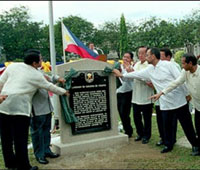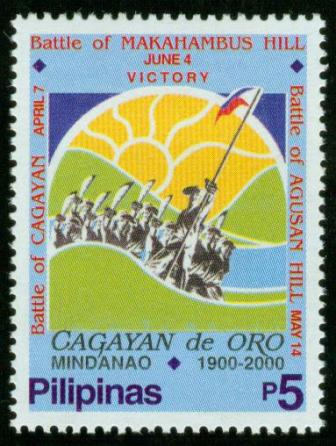Trivia about the Three Battles in Cagayan de Oro City
Cagayan de Misamis, now known as Cagayan de Oro City, was the Capital town of the Segundo Distritc de Misamis in northern Mindanao at the close of the Spanish regime in the Philippines. In December 1898, just after Spain signed the Treaty of Paris with the United States, Misamis organized its first Filipino local government which President Emilio Aguinaldo sanctioned. This revolutionary local government was formally proclaimed on January 10, 1899 in solemn ceremonies outside the Casa Real of Cagayan de Misamis. The Filipino officials ruled uninterrupted until the following year, 1900. On January 16, 1900, learning that America had already taken control of many provinces in Luzon, the Citizens of Cagayan de Misamis gathered and decided to resist the impending American invasion of the town. The people of the town believed that they could no longer capitulate once again under the yoke of another colonial power. Hundreds of its citizens signed what was known as the Club Popular Pact of Resistance which called for an armed warfare against the American invaders under the cri-de guerre “We fight to protect our homes and our liberty,
On March 30, 1900, the Americans invaded the town and took over the reins at the Casa Real under the command of General John Bates and Major James F. Case of the U.S. 40th Volunteer Army. But by that time, a large group of Filipino revolutionaries, led by General Nicolas Capistrano, massed at the Cagayan mountains and organized what came to be known as the Mindanao Battalion.
Early before daybreak of April 7, 1900, just as the drowsy sexton sounded the bell of the town’s San Agustin Church, a mass of revolutionaries, armed only with meager weapons, attacked the center of town. The plan was to scale the barracks of the sleeping American soldiers around the public plaza. The revolutionaries began to scale the barracks with ladders. Just as the fighting started, a group of Bukidnon natives who joined the resistance made a shrilling war cry that awakened the American forces. In no time, the Cagayan revolutionaries with their inferior arms were repelled. Many of them were killed, their dead bodies littering the streets of Cagayan de Misamis. That day of sorrow came to be known as the Battle of Cagayan, or Siete de Abril.
Those who survived reteated back to their stronghold and planned a wider resistance against the Americans.
On May 14,1900, a group of cavalrymen and macheteros under the command of CapitanVicente Roa y Racines were patrolling the eastern coast of Cagayan, in the barrio of Agusan. Challenged by the prospect of another encounter with the Americans, Roa sent a courier to them and dared them to a fight in barrio Agusan. The Americans came not only with their superior might and men but with a battleship escort along the Macajalar Bay. Capitan Roa awaited them at the top of Agusan Hill, in what was planned to be an ambush. But as the Americans approached the foot of the hill, the macheteros who were tasked to attack from behind failed to draw their arms. As a result, Roa and his men atop the hill were overwhelmed by the superior enemy force. As his men lay dead around him, he was given an offer to surrender, but he refused. Finally subdued, the Americans bayoneted him to his death, and had him decapitated, snatching the medals on his breast as a memento of that brave soldier. On top of Agusan Hill lay dead a great number of Filipino patriots who shed their love for Philippine freedom. The event came to be known as the Battle of Agusan Hill. It was the second battle of the Philippine-American War in Cagayan de Misamis.
Despite the overwhelming setbacks, the revolutionaries refused to lay down their arms. On June 4, 1900, a strong force of Americans armed with cannons ventured to the south of Cagayan de Misamis, to search for the revolutionary fortress atop Makahambus Hill. THe force at the hill was commanded by Colonel Apolinar Velez who was assigned by General Capistriano to head the western division of the Mindanao Battlalion. On that fine morning of June 4, the Americans reached the rebel stronghold and made an attempt to negotiate the pass leading to the fortress atop the hill. Suddenly, the rebel cannons roared, leading many American soldiers to their deaths in the steep precipice lined with spears that the Filipinos planted as booby traps. A fierce gunfight ensued with the Americans failing to penetrate the fortress. Finally, as they retreated, a great number of American casualties lay dead, Apolinario Nacalaban, and only three wounded, Lucion Labitad, Gabino Lumindas, and Juan Janolo. The dead American soldiers were buried on the hilltop and one American prisoner-of-war, Sg\. Raymond Moody, was taken into custody. Thus was known the Battle of Makahambus Hill, the first Filipino victory in the Philippine-American War in the entire country, preceding the Battle of Pulang Lupa in Marinduque and the Balangiga Massacre in Samar.
The Cagayan de Misamis theater of the Philippine-American War ended exactly a year after the Battle of Cagayan, on April 7, 1901, in the public plaza of Sumilao,
Bukidnon when General Nicolas Capistrano and his 167 remaining men were subdued and surrendered to the Americans.
The Centennial of the Three Battles will be officially commemorated by the National Historical Institute and the City Government of Cagayan de Oro on April 7, May 14, and June 4, 2000 and the battle sites memorialized with historical markers and full military honors.


Recent Comments